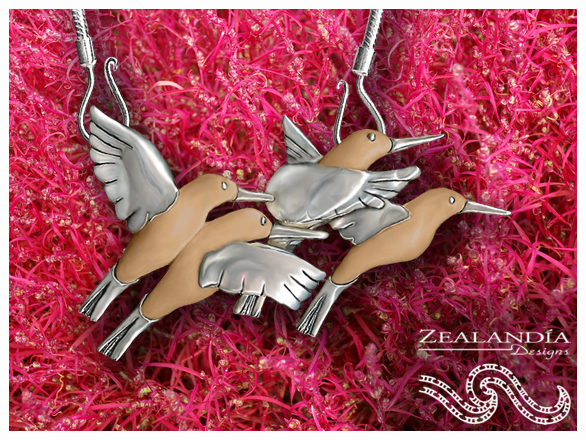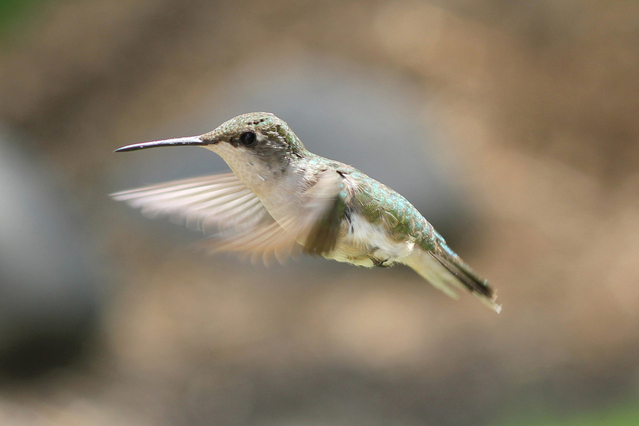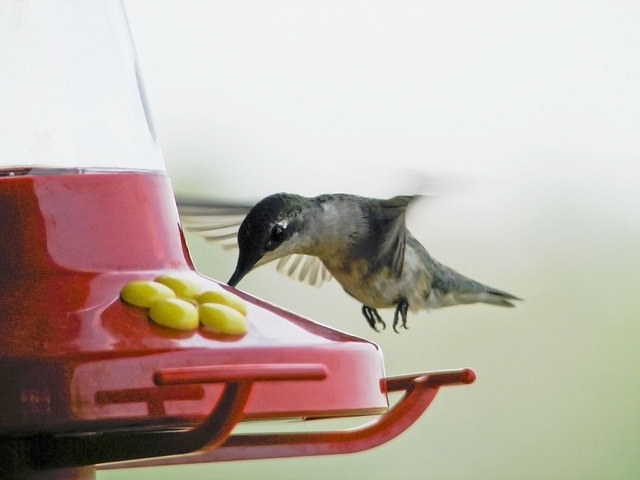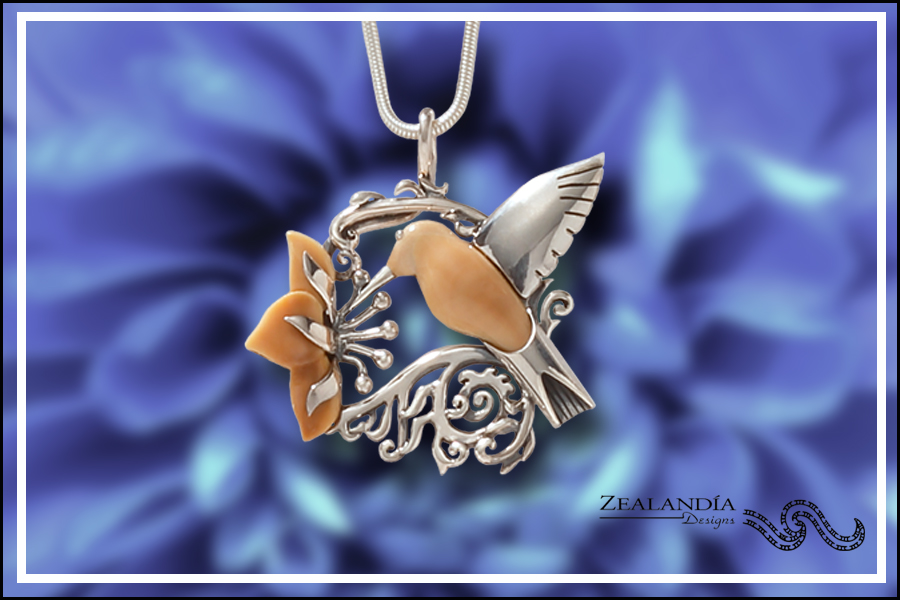The unique hummingbird jewelry at Zealandia Designs is one of our most popular collection of earrings, pendants, and necklaces. The graceful lines and thrilling flight of hummingbirds has inspired many jewelry designs like this gorgeous necklace that features four hummingbirds in-flight, hand carved from fossilized walrus ivory:
[caption id="attachment_253" align="alignnone" width="586"] 'Hummingbirds' - This hummingbird necklace in silver and fossilized ivory depicts a flight of these beloved birds on a hook chain that beautifully accents the delicacy and lines in this favorite piece[/caption]
One of the many wonderful sights and sounds of summer is the magical and enchanting hummingbird. They are the smallest extant bird species and their incredibly rapid flapping is at a frequency audible to humans. The tell-tale buzz alerts us to their presence, sometimes even before we can see them darting through the air, among the trees, above the soccer field, and through the garden.
'Hummingbirds' - This hummingbird necklace in silver and fossilized ivory depicts a flight of these beloved birds on a hook chain that beautifully accents the delicacy and lines in this favorite piece[/caption]
One of the many wonderful sights and sounds of summer is the magical and enchanting hummingbird. They are the smallest extant bird species and their incredibly rapid flapping is at a frequency audible to humans. The tell-tale buzz alerts us to their presence, sometimes even before we can see them darting through the air, among the trees, above the soccer field, and through the garden.
 Like dragonflies, hummingbirds can fly up, down, left, right, forward, backwards and can even hover. When they hover, hummingbirds flap their wings in a figure-8 motion, roughly 50 times per second. The flap is stronger on the pull up than the push down, which creates appropriate lift to keep them in mid-air. Their rapid flight requires a lot of calories, which is mostly drawn from various nectar sources. Each day they consume 100-200% of their body weight in nectar, depending on the sugar content of the nectar. Their lower beak is flexible and can bend up to 25 degrees to help them catch protein-rich bugs.
Like dragonflies, hummingbirds can fly up, down, left, right, forward, backwards and can even hover. When they hover, hummingbirds flap their wings in a figure-8 motion, roughly 50 times per second. The flap is stronger on the pull up than the push down, which creates appropriate lift to keep them in mid-air. Their rapid flight requires a lot of calories, which is mostly drawn from various nectar sources. Each day they consume 100-200% of their body weight in nectar, depending on the sugar content of the nectar. Their lower beak is flexible and can bend up to 25 degrees to help them catch protein-rich bugs.
 Hummingbird hovering at a sugar water feeder[/caption]
Hummingbirds are nectarivores, which means their diet consists either exclusively or primarily on nectar-producing flowering plants. Many people enjoy putting out hummingbird feeders to entice the little sprites to come closer. The Hummingbird Society has some very helpful information about feeders including that you should never use red food dye and only fill the feeder with white granulated sugar mixed with water (not brown sugar, raw sugar or other sweeteners). For more information, take a look here: http://www.hummingbirdsociety.org/index-inside.php?Hummingbirds-101-Feeding-Hummingbirds-19
If you’d like to offer natural sources of nectar to attract hummingbirds, consider growing columbine, trumpet vine, honeysuckle, bee balm, salvia, larkspur, cornflower, or zinnias. These flowers also attract bees and butterflies, so it’s a win win win win for everyone.
Hummingbird hovering at a sugar water feeder[/caption]
Hummingbirds are nectarivores, which means their diet consists either exclusively or primarily on nectar-producing flowering plants. Many people enjoy putting out hummingbird feeders to entice the little sprites to come closer. The Hummingbird Society has some very helpful information about feeders including that you should never use red food dye and only fill the feeder with white granulated sugar mixed with water (not brown sugar, raw sugar or other sweeteners). For more information, take a look here: http://www.hummingbirdsociety.org/index-inside.php?Hummingbirds-101-Feeding-Hummingbirds-19
If you’d like to offer natural sources of nectar to attract hummingbirds, consider growing columbine, trumpet vine, honeysuckle, bee balm, salvia, larkspur, cornflower, or zinnias. These flowers also attract bees and butterflies, so it’s a win win win win for everyone.
 'Hummingbird Spring' - Our fossilized ivory and silver hummingbird pendant depicts the graceful hummingbird sipping nectar in an art nouveau inspired setting.[/caption]
'Hummingbird Spring' - Our fossilized ivory and silver hummingbird pendant depicts the graceful hummingbird sipping nectar in an art nouveau inspired setting.[/caption]
 'Hummingbirds' - This hummingbird necklace in silver and fossilized ivory depicts a flight of these beloved birds on a hook chain that beautifully accents the delicacy and lines in this favorite piece[/caption]
One of the many wonderful sights and sounds of summer is the magical and enchanting hummingbird. They are the smallest extant bird species and their incredibly rapid flapping is at a frequency audible to humans. The tell-tale buzz alerts us to their presence, sometimes even before we can see them darting through the air, among the trees, above the soccer field, and through the garden.
'Hummingbirds' - This hummingbird necklace in silver and fossilized ivory depicts a flight of these beloved birds on a hook chain that beautifully accents the delicacy and lines in this favorite piece[/caption]
One of the many wonderful sights and sounds of summer is the magical and enchanting hummingbird. They are the smallest extant bird species and their incredibly rapid flapping is at a frequency audible to humans. The tell-tale buzz alerts us to their presence, sometimes even before we can see them darting through the air, among the trees, above the soccer field, and through the garden.
Hummingbirds are known for their unique flying habits
 Like dragonflies, hummingbirds can fly up, down, left, right, forward, backwards and can even hover. When they hover, hummingbirds flap their wings in a figure-8 motion, roughly 50 times per second. The flap is stronger on the pull up than the push down, which creates appropriate lift to keep them in mid-air. Their rapid flight requires a lot of calories, which is mostly drawn from various nectar sources. Each day they consume 100-200% of their body weight in nectar, depending on the sugar content of the nectar. Their lower beak is flexible and can bend up to 25 degrees to help them catch protein-rich bugs.
Like dragonflies, hummingbirds can fly up, down, left, right, forward, backwards and can even hover. When they hover, hummingbirds flap their wings in a figure-8 motion, roughly 50 times per second. The flap is stronger on the pull up than the push down, which creates appropriate lift to keep them in mid-air. Their rapid flight requires a lot of calories, which is mostly drawn from various nectar sources. Each day they consume 100-200% of their body weight in nectar, depending on the sugar content of the nectar. Their lower beak is flexible and can bend up to 25 degrees to help them catch protein-rich bugs.
Want to attract more hummingbirds to your yard?
[caption id="attachment_254" align="alignright" width="376"] Hummingbird hovering at a sugar water feeder[/caption]
Hummingbirds are nectarivores, which means their diet consists either exclusively or primarily on nectar-producing flowering plants. Many people enjoy putting out hummingbird feeders to entice the little sprites to come closer. The Hummingbird Society has some very helpful information about feeders including that you should never use red food dye and only fill the feeder with white granulated sugar mixed with water (not brown sugar, raw sugar or other sweeteners). For more information, take a look here: http://www.hummingbirdsociety.org/index-inside.php?Hummingbirds-101-Feeding-Hummingbirds-19
If you’d like to offer natural sources of nectar to attract hummingbirds, consider growing columbine, trumpet vine, honeysuckle, bee balm, salvia, larkspur, cornflower, or zinnias. These flowers also attract bees and butterflies, so it’s a win win win win for everyone.
Hummingbird hovering at a sugar water feeder[/caption]
Hummingbirds are nectarivores, which means their diet consists either exclusively or primarily on nectar-producing flowering plants. Many people enjoy putting out hummingbird feeders to entice the little sprites to come closer. The Hummingbird Society has some very helpful information about feeders including that you should never use red food dye and only fill the feeder with white granulated sugar mixed with water (not brown sugar, raw sugar or other sweeteners). For more information, take a look here: http://www.hummingbirdsociety.org/index-inside.php?Hummingbirds-101-Feeding-Hummingbirds-19
If you’d like to offer natural sources of nectar to attract hummingbirds, consider growing columbine, trumpet vine, honeysuckle, bee balm, salvia, larkspur, cornflower, or zinnias. These flowers also attract bees and butterflies, so it’s a win win win win for everyone.
Unique Hummingbird Jewelry, Then and Now
Hummingbirds have enchanted humans throughout history. The Aztecs wore hummingbird talismans to symbolize vigor and energy. They also believed fallen warriors would return as hummingbirds and butterflies. Hummingbirds have always fascinated us earth bound humans, who are left to gaze in wonderment as they zip about overhead. Our unique hummingbird jewelry is a nod to these thrilling flyers. [caption id="attachment_256" align="alignnone" width="590"] 'Hummingbird Spring' - Our fossilized ivory and silver hummingbird pendant depicts the graceful hummingbird sipping nectar in an art nouveau inspired setting.[/caption]
'Hummingbird Spring' - Our fossilized ivory and silver hummingbird pendant depicts the graceful hummingbird sipping nectar in an art nouveau inspired setting.[/caption]
